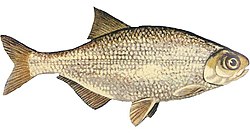| Halecostomi | |
|---|---|
 | |
| Amia calva (bowfin) | |
 | |
| Hiodon tergisus | |
| Scientific classification | |
| Kingdom: | Animalia |
| Phylum: | Chordata |
| Class: | Actinopterygii |
| Subclass: | Neopterygii |
| (unranked): | Halecostomi Regan, 1903 |
| Subdivisions | |
Halecostomi is the name of a group of neopterygian fish uniting the halecomorphs (represented by the living bowfin and many extinct groups) and the teleosts, the largest group of extant ray-finned fish. [1]

The Halecostomi hypothesis and the Holostei hypothesis are two competing hypotheses explaining the evolutionary relationships of living ray-finned fish. The Holostei hypothesis is better supported, rendering the Halecostomi a paraphyletic group (i.e., rejecting the Halecostomi hypothesis). [2] [3] [4] [5]
The Holostei hypothesis posits that Ginglymodi (gars and their fossil relatives) and Halecomorphi form a clade, called Holostei, and that the Holostei are the sister group to the Teleostei.
| Neopterygii |
| ||||||||||||
